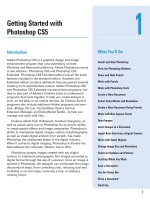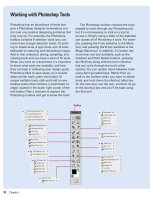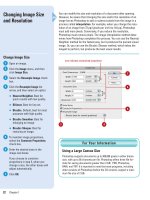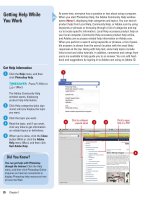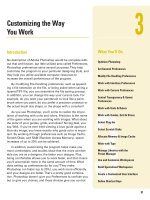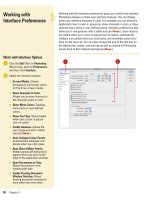Photoshop cs5 by steve Johnson part 6 pot
Bạn đang xem bản rút gọn của tài liệu. Xem và tải ngay bản đầy đủ của tài liệu tại đây (566.5 KB, 7 trang )
ptg
Understanding Navigation
and Measurement Systems
Introduction
When you go on a road trip, you need two things to make
the trip a success: good navigational aids (maps), and an
understanding of how to measure distances between two
points on a road map (1 inch typically equals 100 miles).
When you are working with Adobe Photoshop, one of the
keys to making the journey a success is to understand the
navigational and measurement aids available. Photoshop lets
you choose a measurement system to fit a specific project.
For example, if you're working on images destined for the
Web or a monitor, you'll be using pixels as a measurement
system.
Conversely, if you're outputting to paper, or possibly a
4-color press, you'll likely choose inches or picas. Selecting
between different measurement systems does not impact the
quality of the final image, only how you measure distance.
Trust me on this one; understanding how to measure dis-
tance helps to make the journey an enjoyable experience (I
know from experience).
Having problems squinting at the small details of a photo-
graphic image? Using the Zoom tool is a great way to get
you focused where you need to be. Zooming into a specific
section of a document makes touching up the fine details just
that much easier. In addition, the Info panel gives you up-to-
date information on the exact position of the cursor inside
the document, as well as detailed color information that can
be indispensable in color-correcting an image.
The ability to create text annotations allows you to record
document information that might be vital to the processing
of the image and pass it on to anyone who opens the docu-
ment. Photoshop's navigation and measurement systems are
more than just information; they represent control of the doc-
ument and control of the creative process.
2
2
What You’ll Do
Change the View Size and Area with
the Navigator Panel
Change the Color of the Navigator Panel
View Box
Change the Screen Display Mode
Change the View with the Zoom Tool
Increase or Decrease Magnification
Move Images in the Document Window
Work with Multiple Documents
Work with One Image in
Multiple Windows
Move Layers Between Two
Open Documents
Create Notes
Work with the Info Panel
Change How the Info Panel
Measures Color
Work with Rulers
Create Tool Presets
33
From the Library of Wow! eBook
ptg
34 Chapter 2
Photoshop's Navigator panel gives you an overall view of the image
and the ability to navigate through the document or change the zoom
size. Viewing images at different sizes gives you the ability to focus on
small elements of the design without actually changing the image in
any way. Once small areas of an image are enlarged, it's easier for you
to make minute changes. Zoom size determines the visible size of an
image; the zoom percentage can be seen in the document window.
Zooming in (enlarging the image) by using the handy magnifying glass
lets you work on and manipulate fine details, and then you can zoom
out (reduce the image) to view how the changes impact the entire
image. The Navigator panel contains a thumbnail view of the image,
and under the thumbnail are easy-to-use controls that let you adjust
the zoom of the image. In addition, changes made in the Navigator
panel are immediately viewable in the active document window (what
you see is what you get).
Changing the View
Size with the
Navigator Panel
Change the View Size with the
Navigator Panel
Select the Navigator panel.
Use one of the following methods
to change the view size:
◆ Drag the triangular slider to the
right to increase the zoom or to
the left to decrease the zoom.
◆ Click the small and large
mountain icons, located to the
left and right of the triangular
slider, to decrease or increase
the zoom.
◆ Enter a value from .33% to
1600% into the Zoom box.
2
1
1
Click mountain icons to increase
or decrease the zoom.
Drag slider to zoom
Enter a zoom
value
Did You Know?
There are additional ways to zoom in
using the Navigator panel.
In the View
box, hold down the Ctrl key, and then
drag to resize the active document.
You can constrain the view box to
drag horizontally or vertically.
Hold
down the Shift key, and then drag the
view box horizontally or vertically.
Navigator Panel Shortcut
You can control the view of the document through a great shortcut.
Simply click once in the Zoom input box on the Navigator panel, and
then use the Up/Down arrow keys to increase or decrease the zoom
value of the document 1% at a time. Not fast enough for you? Then
hold down the Shift key, and use the Up/Down arrow keys to change
the zoom size 10% at a time. Press the Enter key to see your changes
reflected in the active document window.
For Your Information
From the Library of Wow! eBook
ptg
Chapter 2 Understanding Navigation and Measurement Systems 35
Zoomed images are typically larger than the size of the document win-
dow. When this happens, Photoshop adds navigational scroll bars to
the bottom and the right of the document window. However, using
scroll bars is not the only way to change your position within the image;
the Navigator panel gives you a visible approach to changing the view-
able area of the image. The view box in the Navigator panel represents
the visible boundaries of the active document window, which is the
viewable area of the image.
Changing the View
Area with the
Navigator Panel
Change the View Area with the
Navigator Panel
Select the Navigator panel.
Drag the view box in the thumbnail
of the active image.
Click within the thumbnail.
The position of the view box
changes, which also changes the
viewable area of the image in the
document window.
3
2
1
3
1
2
Did You Know?
You can show the Navigator panel.
If
the Navigator panel is not visible, click
the Window menu, and then click
Navigator.
You can change the Zoom size of an
image using the Navigator thumbnail.
Hold down the Ctrl key (Win) or the A
key (Mac), and then drag in the thumb-
nail. When you release your mouse,
the selected area expands. It's just like
using the Zoom tool, except you're
dragging in the Navigator's thumbnail.
Conversely, if you drag a second time
(this time using a larger rectangle), the
image zooms out.
From the Library of Wow! eBook
ptg
36 Chapter 2
The colored box in the Navigator panel (proxy preview area) defines
the viewable area of the image. It's important for the colored lines of
the view box to stand out clearly against the image. The default color of
the view box is a light red; however, some documents contain images
that are predominantly the same color as the colored lines of the view-
able area, making the viewing area difficult to identify. By changing the
color of the lines, you can make sure they stand out against the image.
This may seem like a small thing, but choosing a color that contrasts
with my image significantly cuts down on my frustration level when I'm
attempting to identify the viewable area.
Changing the Color of
the Navigator Panel
View Box
Change the View Box Color
Select the Navigator panel.
Click the Navigator Options button,
and then click Panel Options.
Click the Color list arrow, and then
click a predefined color, or click
Custom to select a color from the
Color Picker dialog box.
Click OK.
4
3
2
1
View box
3
4
1
2
Did You Know?
You can increase the size of the
Navigator panel’s thumbnail.
Drag the lower right corner of the
Navigator panel to expand the size of
the panel. As the Navigator panel
increases in size, so does the
thumbnail.
From the Library of Wow! eBook
ptg
Chapter 2 Understanding Navigation and Measurement Systems 37
In Photoshop, the Screen Display mode determines the background
displayed behind the active image. For example, you can choose a
Screen Mode that changes the background to black, and then hides all
the panels. Since monitor backgrounds, combined with Photoshop's
panels, add distracting colors to your workspace, changing the Screen
Mode gives you a chance to isolate your image against a solid color
background. Viewing your images against a black or gray background
helps your eyes identify the true colors within an image.
Changing the Screen
Display Mode
Change the Screen Mode
Click Change Screen Mode button
to toggle between screen modes
or click the Change Screen Mode
button arrow, and then select the
mode you want:
◆ Standard Screen Mode.
Displays the image against a
gray, black, or custom color
background (Win), or with the
visible desktop (Mac). All
menus and panels are visible.
◆ Full Screen Mode with Menu
Bar. Centers the image, and
displays it against a gray, black,
or custom color background.
◆ Full Screen Mode. Centers the
image, and displays it against a
gray, black, or custom color
background. (Default: Black)
TIMESAVER
Press F to toggle
between the screen modes.
1
Full Screen Mode
with Menu Bar
Full Screen Mode
1
Standard Screen
Mode
Did You Know?
You can temporarily hide all of the
panels and toolbox.
Press the Tab key
to hide the toolbox and panels. Press
the Tab key a second time to display
the hidden toolbox and panels. Hold
down the Shift key, and then press the
Tab key to hide the panels, but not the
Toolbo x or Option s ba r. In In terfac e
preferences, you can choose to have
either a border, a drop shadow or no
effect for each screen mode.
From the Library of Wow! eBook
ptg
38 Chapter 2
Working with the Zoom tool gives you one more way to control exactly
what you see in Photoshop. Just like the Navigator panel, the Zoom tool
does not change the active image, but allows you to view the image at
different magnifications. The Zoom tool is located towards the bottom
of Photoshop's toolbox, and resembles a magnifying glass. The maxi-
mum magnification of a Photoshop document is 1600%, and the mini-
mum size is 1 pixel. Increasing the magnification of an image gives you
control over what you see and gives you control over how you work.
Large documents are difficult to work with and difficult to view. Many
large documents, when viewed at 100%, are larger than the maximum
size of the document window, requiring you to reduce the zoom in order
to view the entire image.
Changing the View
with the Zoom Tool
Zoom In the View of an Image
Select the Zoom tool on the
toolbox.
Use one of the following methods:
◆ Click on the document.
The image increases in
magnification centered
on where you clicked.
◆ Drag to define an area with the
Zoom tool.
The image increases in
magnification based on the
boundaries of the area you
dragged. When you zoom in to
500% or more magnification, a
Pixel Grid will appear, making it
easy to make pixel-specific
modifications.
◆ Bird's Eye View.
If you are zoomed into an
image, you can press and hold
the H key, click with your
mouse and zoom out. Then
reposition the viewing
rectangle to the next spot you
want to zoom into and it will
zoom you into that specific
spot.
2
1
1
2
Zoom in
Click and drag method
From the Library of Wow! eBook
ptg
Chapter 2 Understanding Navigation and Measurement Systems 39
Zoom Out the View of an Image
Select the Zoom tool on the
toolbox.
Hold down the Alt (Win) or Option
(Mac) key, and then click on the
screen to reduce the zoom of the
active document.
The zoom reduction centers on
where you click on the active
document.
IMPORTANT
Since images
viewed in Photoshop are
composed of pixels (like bricks in a
wall), the only way to really see
what the printed results of your
artwork will look like is to view the
image (even if it is too big for the
screen) at 100%.
2
1
1
2
Zoom out
Did You Know?
You can zoom in or out using shortcut
keys regardless of what tool you’re
currently using.
To zoom i n, p re ss
Ctrl+Spacebar (Win) or A+Spacebar
(Mac) and click or drag to define an
area. To zoom out, press Ctrl+Space-
bar+Alt (Win) or A+Spacebar+Option
(Mac) and click or drag to define an
area.
You can always display a clear view.
When you zoomed into your image at
33% or 66% in previous versions of
Photoshop, you would get a jaggy pre-
view. Now, no matter what magnifica-
tion size you choose, the preview is
crisp and clear.
From the Library of Wow! eBook
